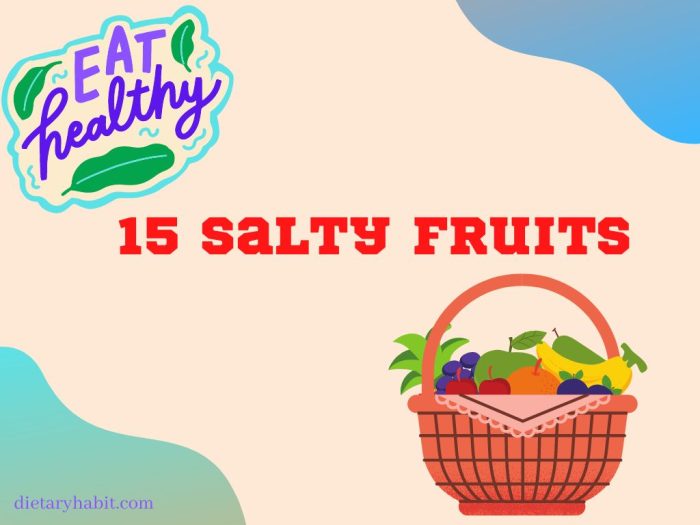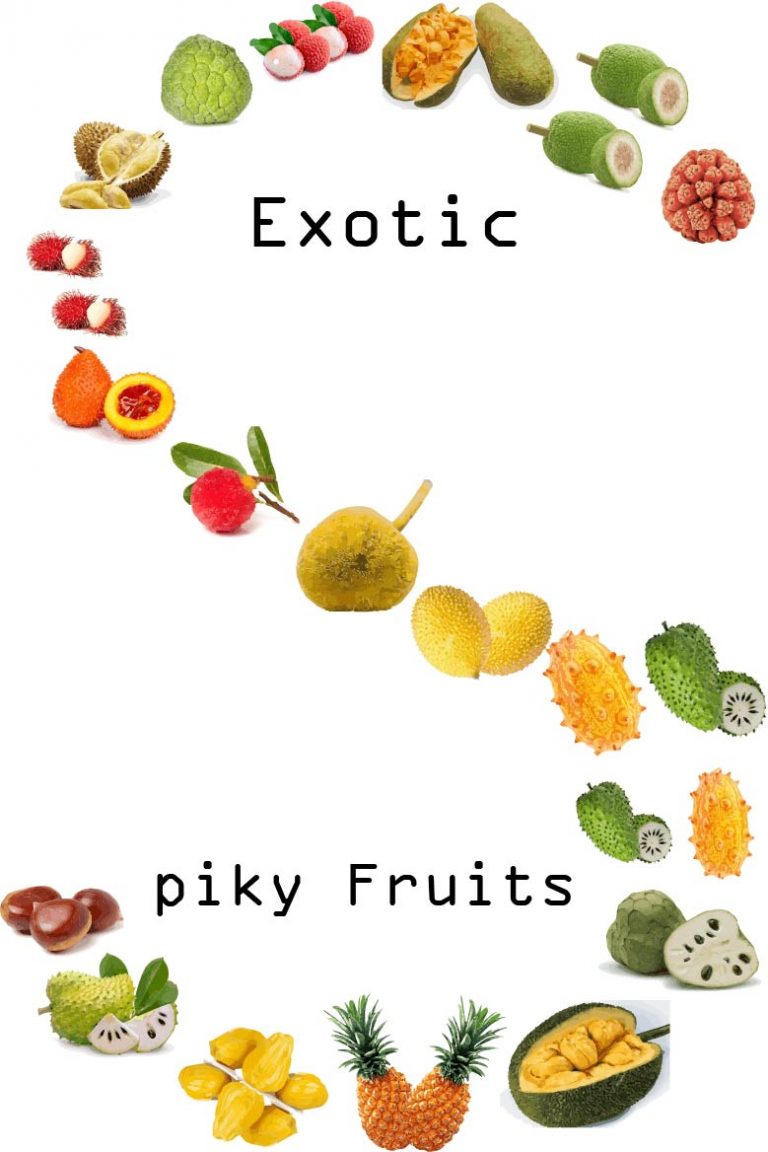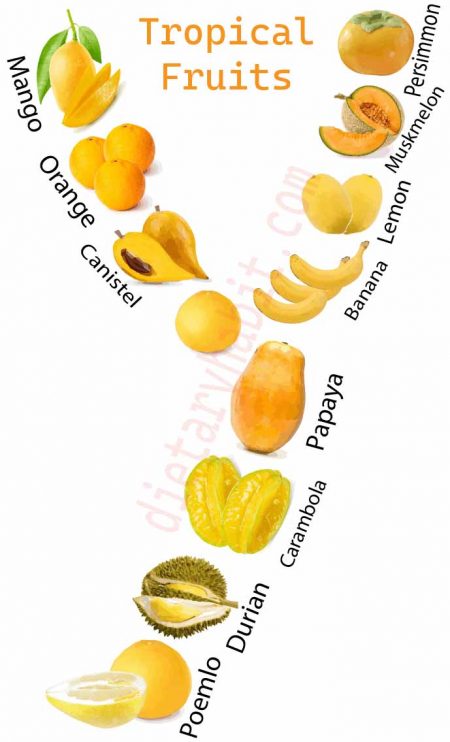15 Salty Fruits for Tastebud Revolution

Is there a salty fruit? Ask no more! Before you delve into our list of 15 salty fruits, you should know that naturally salty fruits are rare except for a few one. You’ll know that later in this article. However, most salty fruits obtain their high sodium and potassium content during processing, canning, and other methods of preservation.
Fresh fruits, even being salty, never stand a threat as they have low to no sodium content. Instead, you need to replace your junk food lists with a rainbow of fresh fruits. But in cities, fresh fruits are a luxury. That’s why you need to be careful when choosing processed fruits from the stores.
Americans are already consuming more salts than the recommended level. An average American consumes almost 3436 mg of sodium while the recommended level is only 2300 mg per day. It’s okay sometimes if you’re a healthy joe. Your body system will try to maintain homeostasis. But if you’re an ailing one suffering from hypertension or heart disease, your salt intake should be limited to 1500 mg of sodium chloride per day. Otherwise, you’re in grave danger.
That’s when you need to avoid high-sodium or salty fruits from your diet. Fresh fruits are still OKAY. Even salty fruits aren’t necessarily harmful to your health. But you should reconsider choosing fruits so that your daily salt intake doesn’t exceed the recommended level. It’s right to avoid flavorful salted foods than being food for disease. Remember, only a tiny portion of your daily salt intake comes from table salt.
So what are some salty fruits? Without any further ado, let’s find out which salty fruits to avoid and which are to eat if they’re low in sodium.
Types of Salty Fruits
Salty fruits are rarely fresh or frozen fruits. The processed and canned ones contain the highest sodium. Salty fruits can be categorized into high-sodium, low-sodium, very low-sodium, and sodium-free fruits. Highly salty fruits contain more than 145mg of sodium, and low-sodium salty fruits contain 35mg to 145mg. Fresh fruits can be counted in the low-sodium list, while canned and processed fruits top the list of highly salty fruits.
Here we’ve enlisted some of the salty fruits that are high in sodium and some fruits that are low in sodium. As we’ve enrolled the fruits based on their salty taste, potassium-rich fruits are also included as potassium chloride in foods has the same salty taste as that of the sodium-rich foods.
- Umeboshi
If you’re a hale and hearty person who loves to indulge their taste buds with salt, then umeboshi can be a great choice to add to your main dish of rice or pilaf. It’s prepared by drying or pickling the ume fruits. The salty flavor surpasses its citrus tone poured with acids. The side dish can sway your tastebuds, giving a refreshing vibe.
100g umeboshi contains almost 8700mg of sodium which is sky-high if you compare it to the low-sodium fresh fruits. We usually consume a lot of salt in our daily meals. Hence adding a few umeboshi can surpass the recommended level of salt intake. Though umeboshi is an extremely salty fruit, it has a chockfull of health benefits to offer. It contains polyphenols and other compounds that contribute to normal blood pressure and an active immune system.
- Pigface fruit
Pigface fruit is the only fresh fruit we’ve found to be naturally salty. That means pigface fruit naturally contains more than 145 mg of sodium. So much so that Australian aborigines use the pigface leaves as a replacement for salt in their dishes. This bush fruit mainly grows on the south coast of Australia. Some are trying to grow them in the specific salty conditions in America since the succulent pulp of pigface fruit is mesmerizing.
The daisy-like flower bears a small reddish-purple fruit that’s exquisitely salty. Some compare the taste to that of a salty apple, while others mention the taste as fig. Indigenous Australians use pigface plants for various purposes. They can boost your immunity, and heal jellyfish stings, insect bites, etc. The rich dietary fiber content makes them a good example of laxatives.
- Mammy apple
Mammy apple is a low-sodium fruit containing 127 mg of sodium, much higher compared to other fresh fruits. The salty fruit resembles a sapodilla or sofeda. However, the aromatic fragrance and awkwardly sweet flavor musk the salty taste, if there’s any. Whatever the taste is, mammy apple certainly has an abundance of sodium that might be harmful if your total daily salt intake surpasses the recommended level.
The apricot-like flavor is indulgent when eaten raw or cooked. The succulent fruit can be eaten as a dessert for its sweetness. Also, mammy apples are appealing as jam, jelly, sauce, or tart. You can eat a mammy apple without any hesitation. But don’t get past your daily salt intake.
- Pickled olives
Fresh olives aren’t so palatable for their bitter taste due to the presence of a chemical, oleuropein. But still, fresh olives taste good mixing with salt. It’s a common way to eat fresh green olives in the Indian subcontinent. However, to remove the bitterness, olives are cured and processed in a proper way. Olives can be cured by using brine, salts, water, or lye.
Pickled olives contain 1556 mg of sodium which is 68% of total calories. They are highly salty fruits that can deter the health condition of a diseased person. Pickled olives are still good for healthy people as they maintain good bowel habits. However, you should be careful even if you’re a healthy joe. Olive is commonly cured by brine which is a saturated solution of salt. Avoiding pickled olives is the best option if you don’t like green olives.
- Guava
Guava isn’t a salty fruit itself. But a guava without masala salt can be as bland as a timber. Being a salt bae while eating guavas can undermine your health condition. So the first thing to avoid is the use of masala or tasting salt in guava. The Indians are a fan of such a salt-unripe fruit combo.
Guava contains a high amount of potassium as well as sodium. It contributes to better blood pressure control. Heart health significantly improves if you eat one or two guavas a day. The high amount of sodium and potassium has an enormous effect on maintaining electrolyte balance. Though it doesn’t taste salty, it has an abundance of sodium and potassium.
- Tomatoes
Tomatoes are sundried for better flavor and longer shelf life. They are left in the open areas to be heated by sun rays. The days-long drying process removes most of the water content of tomatoes. When the moisture is removed mostly, the skin thickens and ultimately produces soft and pulpy skin. The thick skin prevents any infiltration of microorganisms into the salty fruits. But where does the salt come from? Before drying them, tomatoes are mixed with salt or sulfur dioxide. The enormous salt content thus comes into being during the sun-drying process.
Sun-dried tomatoes contain 266 mg of sodium per 100g weight. Though it’s a salty fruit, sun-dried tomato contains some beneficial trace elements. Lycopene is the most significant of them. It’s a powerful antioxidant that prevents many cancers and improves skin conditions. The sun-drying process also concentrates the flavoring ingredients, hence more taste.
- Passion fruit
This tropical fruit is gaining traction these days among health-conscious people. The fruit is small yet jampacked with much-needed nutrients, antioxidants, and essential minerals. Passion fruit has tough skin with a mushy core containing many seeds. The juicy inner layer is perfect for making a nutritious passion fruit juice. The nutrition profile is rich compared to its small size.
Passion fruit contains only 28 mg of sodium, while potassium is 348 mg, which is much higher than many fresh fruits. And the sodium-potassium combo doesn’t provide a salty flavor but rather a sweet and sour taste. The tartness can indicate potentially salty passion fruit, but it’s masked by a pineapple-like taste. Passion fruit has many other health benefits due to its richness in fibers and minerals. The low glycemic index is helpful for diabetic patients.
- Salted plums
If you’re a fan of Mexican saladitos and craving it, it’s time to quit that unhealthy food. The extreme salt content of saladitos can damage your baroreceptor mechanism badly. Salted plums may be beneficial in many ways, but it’s not wise to consume them if you’re a hypertensive patient or a health-conscious person. If you love the sour flavor, you may try the salted plums as fruit considering its other adverse effects. Sucking the hard core of salted plums contributes to better bowel condition.
Predictably, salted plums contain an astonishing amount of salt, which is 904 mg of sodium and 400 mg of potassium. If you’re a fan of salty fruits, then salty plums can be an excellent option for you. You can eat salted plums in various ways. You can use it with plain rice or in your salads. The low-calorie content can help you in maintaining your strict diet. The licorice mixture that’s used to cure the dried prunes may cause other adversaries as it’s responsible for the savory flavor.
- Salted peanuts
Using salt in peanuts concentrates the flavor. And at the same time, it increases the risk of heart disease. Roasted and salted peanuts are popular snacks in the West. The salty taste just refreshes the tastebuds. But the key is to eat the salt peanuts in moderation. If you incorporate salted peanuts in a balanced diet, then it’s primarily risk-free and helpful for health.
Salted peanuts are also high in salt containing 390 mg of salt in a 250g KP salted peanuts package. Raw peanuts contain only 5mg of sodium, whereas salted peanuts contain almost 80 fold of this amount. If you can avoid added salts, you may obtain the full potential of peanuts. Peanuts are rich in dietary fibers that can keep you full for a longer period. But you should eat peanuts in moderation as they’re high in fat, calories, and salt.
- Applesauce
Apple is a healthy fruit that’s widely known as an immune enhancer. It’s popular among health-conscious people as it has an incredible nutrition profile. You must know the proverb, ‘an apple a day, keeps the doctor away.’ But what about the apple-based sauce? Applesauce isn’t a new cuisine in the modern world but dates back to medieval Europe. Apple sauce was used with the different dishes of beef, pork, fish, etc.
There is a variety of apple sauces ranging from sweet and tart to salty. Applesauce is just a cooked version of the apple. There are different ways to prepare an apple sauce, even by simply adding apple, water, and sweet or salt. If you want to enjoy a salty applesauce, you can prepare it by adding sufficient salt. Applesauce has lots of health benefits if made properly. Using the whole apple with rind can offer more health benefits, including a functioning digestive system, formation of blood vessels, cartilage, etc.
- Dried apples
If you’re interested in finding a hassle-free, healthy, and long-lasting snack for your kid, dried apples could be a good try. It’s not a fancy treat but rather an easy way to prepare the delicious dried apple. The texture resembles a potato chip, while the flavor reminds you of apple pie. That’s why your kids might like it as an after-school snack. You can prepare a large batch of dried apples by a straightforward dehydrating process.
100 gm dried apple contains 87 mg sodium and 450 mg potassium. The salt amount indicates it to be a low-sodium salty fruit. However, dried apples are a healthy alternative to salty potato chips. The dried apple tastes good if nibbed in the salt. Dried apples have more health benefits than any other dried fruit. It contains lots of soluble and insoluble fibers enhancing the normal bowel habit.
- Cranberry salad
Cranberry salad is an exciting addition to our list of salty fruits. If you want to attain sound health with a good heart, the choice of food is significant. Cranberry salad includes lots of other stuff that can benefit you. But the overall salt content is high. Dipping the fresh cranberries in maple syrup combined with other ingredients, you can easily prepare a delightful cranberry salad along with your Thanksgiving turkey.
Cranberry salad contains 209.5 mg of sodium per serving. It has a high volume of salt that should be okay if incorporated into a balanced diet. This colorful and delicious salad is perfect to kickstart a hectic day. Cranberry salad has a balanced sweet flavor, not overpowered by extreme sweetness or saltiness. You can use crunchy walnuts, apples, marshmallows, crisp celery, etc.
- Cranberry sauce
A thanksgiving dinner without spreading cranberry sauce or jam over the turkey seems boring as beans. It’s the day you would want that your sauce never end. You can use fresh or frozen cranberries to prepare your favorite cranberry sauce. The tartness of cranberry should be balanced by adding sugar syrup. The right combo produces a refreshing flavor that beautifully goes with the meat flavor of turkey.
But what about the salty cranberry sauce? Isn’t cranberry a salty fruit? Cranberry sauce contains 29 mg salt which isn’t much higher. Still, it has comparatively more salt than most other fresh fruits. If you properly freeze the cranberry sauce in the freezer, you can use it for almost 15 days. However, we can’t complain about amusing your tastebuds with some cranberry sauce in the thanksgiving ceremony.
- Cranberry relish
There’s a basic difference between cranberry sauce and cranberry relish. Cranberry relish is prepared by blending raw cranberries in a blender whereas cranberry sauce is made by cooking the salty fruits. If you’re a cranberry fan, the quick and easy process of making cranberry orange relish is for you. You’re still getting the delectable raw flavor and cramming nutrients.
- Apple juice
Apple is a superfood with plenty of health benefits. You can furnish the apple flavor with other ingredients and take it for better nourishment. It doesn’t need much effort as the procedure is quick and straightforward. If you want to enhance the flavor of the juice, you need to add some salt. And hence you’re having salty fruit juice of apple. You can avoid the salt if you want by compromising the flavor for a little bit. However, apple juice can still benefits you by adding muscle bulk and maintaining your bowel health.
What Fruits Are Naturally Salty
Naturally salty fruits may not be the first thing that comes to mind when you think of salty foods, but there are several varieties that pack a flavorful punch. These fruits can add a unique and delicious twist to your meals without the need for added salt or other flavorings. Here are some of the best naturally salty fruits you can try:
- Olives: These small, oval-shaped fruits are a popular ingredient in many Mediterranean dishes. They are rich in healthy fats and have a distinct salty and tangy flavor that pairs well with many different types of food.
- Pineapple: This tropical fruit is known for its sweet and tangy flavor, but did you know that the core of the pineapple has a slightly salty taste? This unexpected twist can add depth to your favorite pineapple dishes.
- Tomatoes: While many people consider tomatoes to be a vegetable, they are actually a fruit. Tomatoes have a slightly salty taste that can enhance the flavor of many dishes. They are also a good source of vitamins A and C.
- Coconuts: Coconuts are a versatile tropical fruit that are used in many different types of cuisine. The water and flesh of the coconut are naturally sweet, but they also have a slightly salty taste that can add complexity to your dishes.
- Grapefruit: This citrus fruit is known for its bitter and tangy taste. It also has a slightly salty flavor, which can be a nice contrast to the sweetness of the fruit. Grapefruit is also high in vitamin C and other antioxidants.
Incorporating these naturally salty fruits into your meals can add a burst of flavor and nutrition to your diet. Whether you enjoy them as a snack, in salads, or in other dishes, these fruits are a delicious and healthy way to satisfy your taste buds.
What Is The Saltiest Fruit
There is actually a fruit that is considered to be the saltiest fruit in the world – it’s called the Salicornia, also known as sea beans or samphire.
Salicornia is a succulent plant that grows in saltwater marshes and mud flats. It is often used in salads, as a garnish, or in pickled form. The plant is incredibly salty due to its ability to absorb salt from the surrounding soil and water, making it an ideal plant for growing in salty environments.
In addition to Salicornia, other fruits such as olives, capers, and some varieties of citrus fruits like pomelo, can also have a naturally salty taste. However, none of these fruits can compare to the saltiness of Salicornia. For those who savor the experience, the taste becomes imprinted in their memory, an ever-present reminder of the pleasure of that initial encounter.
Last Words
In this list, you’ll find what the salty fruits are and how much sodium they contain. Fruits having higher sodium content are regarded as salty fruits. Also, we’ve included some other fruits that have a salty flavor. However, adding salts to any fruits will offer a salty flavor. Some people like adding table salt and tasting salt to bring in some incredible flavor.



